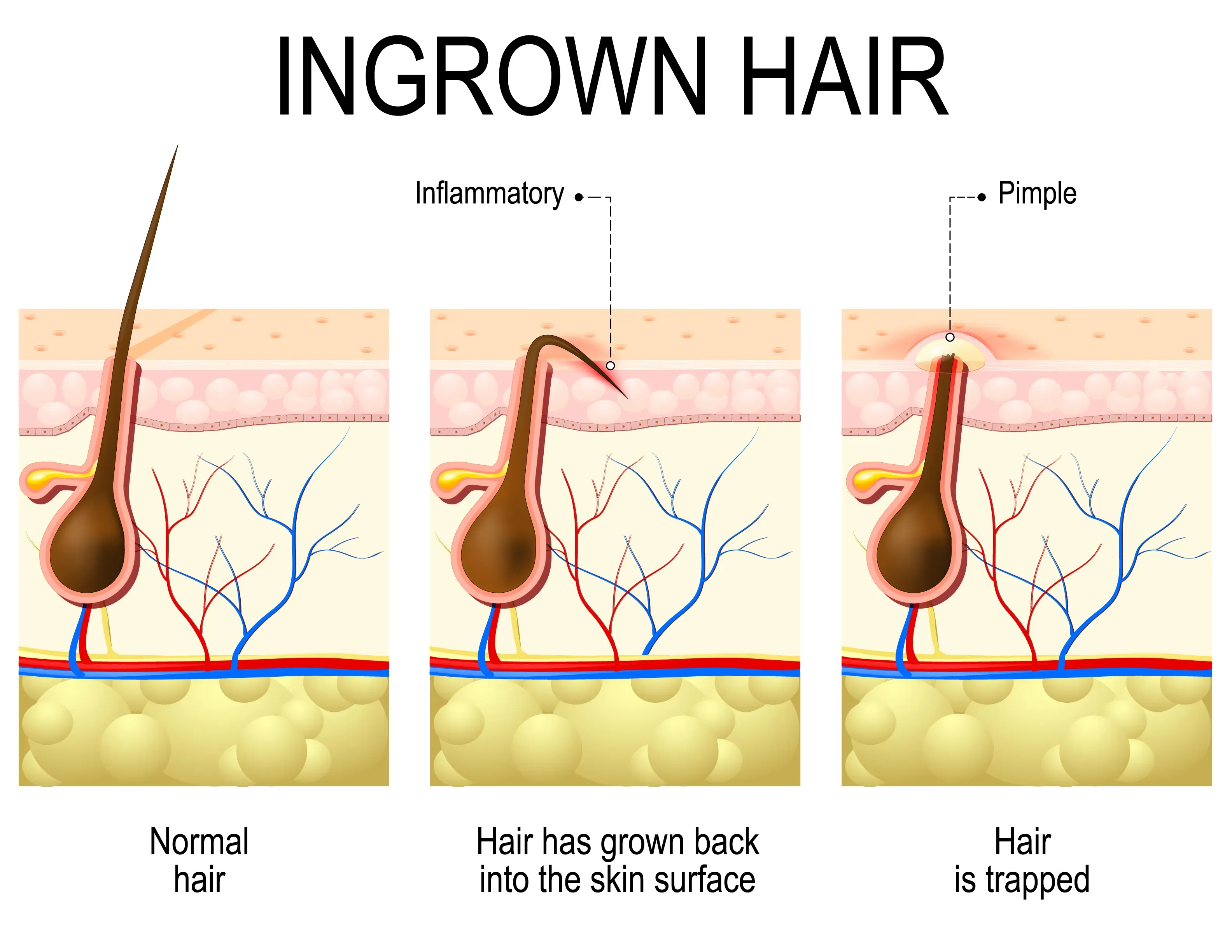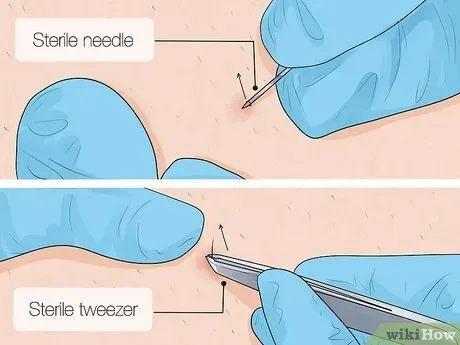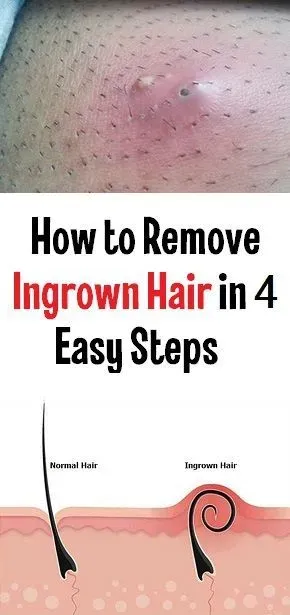Table of Contents
You spot it – that tiny, irritating bump under your skin. It might be red, maybe a little sore, and definitely unwelcome. Yep, looks like you've got yourself an ingrown hair. They pop up after shaving, waxing, or even tweezing, deciding to curl back into your skin instead of growing out like a polite strand should. It's not just annoying; it can be downright painful and sometimes even lead to infection if you're not careful. Feeling the urge to grab tweezers and dig? Hold up. While you definitely want to know how to remove a ingrown hair and get rid of that nuisance, doing it the wrong way can make things much worse, leading to scars or bigger problems. This article is going to walk you through the safe, effective steps you can take at home to deal with that stubborn ingrown hair. We'll also cover when it's time to seek professional help and, perhaps most importantly, how to keep these little devils from making a return appearance.
Spotting That Pesky Ingrown Hair

Spotting That Pesky Ingrown Hair
What an Ingrown Hair Looks Like
so you feel something off after your grooming routine. Maybe it's a little tender, or you see a small bump. What exactly are you looking for when you're trying to identify an ingrown hair? Think of it like this: a hair that decided to take a wrong turn. Instead of growing straight out of the follicle, it curls back and grows into the skin. This often happens in areas where hair is thick or coarse, or where you've recently removed hair.
Visually, it usually starts as a small, red bump. It can look a bit like a pimple, sometimes with a tiny dark spot in the center which is the trapped hair itself. The area around it might be inflamed and tender to the touch. You might even see the hair trying to peek out just under the skin's surface, or it might be completely buried. It's not always obvious, but if you've got irritation in a spot where you remove hair, an ingrown hair is a prime suspect.
Feeling the Signs and Symptoms
Beyond just seeing it, you can often feel an ingrown hair before you spot it. The most common feeling is tenderness or mild pain in the affected area. It can feel itchy, kind of like a persistent little tickle that you can't quite scratch away effectively. Sometimes, especially if it gets irritated or infected, the bump can become quite painful and swollen. It might even feel warm to the touch.
If you're dealing with multiple ingrown hairs in one area, it can create a patch of bumpy, irritated skin. This is often referred to as razor bumps, especially in areas like the beard or bikini line. Don't ignore these signals. Your skin is telling you something isn't right, and catching it early can make dealing with it much easier.
- Small, red bumps
- Tenderness or pain
- Itching
- Inflammation and swelling
- Sometimes, a visible hair trapped under the skin
Common Spots for Ingrown Hairs
While an ingrown hair can technically happen anywhere you have hair, some areas are more prone to them than others. Think about where you typically shave, wax, or pluck. For guys, the face and neck are common culprits, especially if you have coarse beard hair. For women, the legs, bikini line, and underarms are frequent hot spots.
Even if you don't remove hair, tight clothing rubbing against the skin can sometimes contribute to hairs getting trapped. So, if you notice irritation in these usual suspects areas, take a closer look. Knowing the likely places helps you spot them faster and hopefully deal with them before they become a bigger issue.
How to Remove a Ingrown Hair Yourself: Safe Steps

How to Remove a Ingrown Hair Yourself: Safe Steps
Taking Matters Into Your Own Hands (Safely)
Alright, you've spotted the enemy. That little red bump confirms the ingrown hair situation. Your first instinct might be to grab the sharpest thing you can find and go to town. Let's pump the brakes on that impulse, shall we? Trying to forcefully extract an ingrown hair without the right preparation is a fast track to irritation, infection, and potentially a lovely scar you get to keep forever. The goal here isn't violence; it's gentle persuasion. You want to coax the hair out from under the skin's surface, creating a path for it to grow correctly.
Think of it less like a surgical extraction and more like assisting a stubborn plant sprout. You need to soften the soil (your skin) and clear the way. This usually involves warmth and gentle exfoliation to loosen that top layer of skin trapping the hair. Patience is key here. If the hair isn't visible or is deep under the skin, trying to dig it out is a bad idea. You could just push it deeper or cause serious damage. So, before you even think about tweezers, are you sure you're ready to commit to the *safe* process?
- Is the hair visible near the surface?
- Is the area significantly painful or swollen?
- Do you have clean tools ready?
When to Call in the Pros for Ingrown Hair
Look, sometimes that stubborn ingrown hair isn't just a minor annoyance you can tackle with a warm compress and gentle exfoliation. There are definite red flags that signal it's time to put down the tweezers and call in a professional, like a dermatologist or your doctor. If the area around the ingrown hair becomes significantly infected – we're talking increased redness spreading out, intense pain, a lot of swelling, or pus – that's a clear sign something more serious is going on and you need medical intervention. Trying to treat a full-blown infection yourself can lead to it getting worse, potentially causing cellulitis or even scarring. Also, if you have a history of conditions that affect healing or immune function, like diabetes or a compromised immune system, you should be extra cautious and seek professional advice sooner rather than later if an ingrown hair becomes problematic. Don't mess around when your body is showing these signs; professional help ensures proper diagnosis and treatment, often involving prescription antibiotics or a sterile lancing procedure to release the hair and drain any infection.
- Signs of infection: spreading redness, increased pain, significant swelling, pus
- Fever or feeling generally unwell
- The ingrown hair is very large or deep
- You have multiple painful ingrown hairs in one area
- You have a condition affecting healing (like diabetes)
Stopping Ingrown Hairs Before They Start: Prevention Tips

Stopping Ingrown Hairs Before They Start: Prevention Tips
Prepping Your Skin Right
Dealing with an ingrown hair after it pops up is a pain, literally. The real trick is to stop them from forming in the first place. Think of it like preventing a traffic jam instead of trying to navigate through one. It starts before you even think about removing hair. Clean skin is crucial. Wash the area with a mild cleanser to get rid of any dirt, oil, or dead skin cells hanging around. This gunk can block the hair follicle, making it easier for hair to get trapped.
Exfoliation is your best friend in the fight against ingrown hairs. Regularly sloughing off dead skin cells helps keep the surface clear so hair can grow out freely. You can use a physical exfoliant, like a scrub or a brush, or a chemical exfoliant with ingredients like salicylic acid or glycolic acid. Just don't scrub too hard; you're trying to clear a path, not sandblast your skin. Doing this a day or two *before* you remove hair is ideal.
Picking Your Hair Removal Poison (Wisely)
How you remove hair makes a massive difference. Shaving is a common culprit. If you shave, always use a sharp, clean razor. Dull blades cause more tugging and irritation, increasing the risk of hairs curling back. Shave in the direction the hair grows, not against it. Going against the grain gives a closer shave, sure, but it also increases the chance of the hair retracting and getting stuck under the skin. Use a good quality shave gel or cream to provide lubrication.
Waxing and tweezing can also lead to ingrown hairs if the hair breaks off unevenly below the skin's surface. If you wax, ensure the hair is long enough for the wax to grip properly. Pulling strips off quickly and parallel to the skin helps reduce breakage. For a more long-term solution that significantly reduces hair growth and thus the potential for ingrown hairs, methods like laser hair removal are often recommended. Checking out options like those at hairawaybylaser.com can be a game-changer if you're constantly battling these bumps.
- Use a sharp, clean razor
- Shave in the direction of hair growth
- Use shave gel or cream
- For waxing, ensure hair is long enough
- Consider long-term reduction methods like laser
Post-Removal Care Matters
You've successfully removed the hair. Now what? The immediate aftermath is just as important for prevention. The skin is sensitive after hair removal, so treat it kindly. Rinse the area with cool water to close pores and soothe the skin. Avoid applying harsh products or anything heavily fragranced right away.
Keeping the skin moisturized helps keep it supple and makes it easier for new hairs to grow out. Look for lotions or oils that are non-comedogenic, meaning they won't clog your pores. Some people find products containing salicylic acid or witch hazel helpful for keeping follicles clear after hair removal, but test them on a small area first to make sure they don't cause irritation. Also, try to avoid tight clothing that rubs against the skin immediately after hair removal, as this friction can irritate the follicles and contribute to hairs getting trapped. Give your skin some space to breathe.
Saying Goodbye to Ingrown Hairs
Dealing with an ingrown hair doesn't have to be a painful ordeal or lead to lasting marks. By understanding how to remove a ingrown hair safely, you can often resolve the issue at home using gentle methods like warm compresses and careful exfoliation. Remember, patience and cleanliness are key to avoiding infection and scarring. Trying to force it out or pick at it usually backfires. More importantly, incorporating preventative steps into your routine, like proper exfoliation and choosing hair removal methods that work best for your skin, can significantly reduce your chances of seeing these unwelcome bumps reappear. If an ingrown hair becomes infected, very painful, or doesn't improve with home care, don't hesitate to consult a healthcare professional. Taking these steps helps ensure your skin stays smooth and happy, free from the irritation and discomfort of ingrown hairs.
